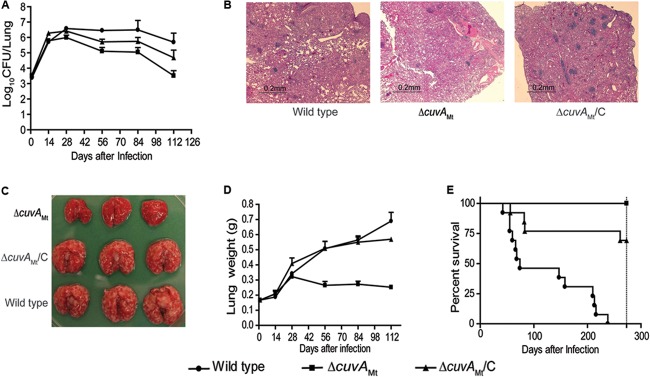FIG 7.

Mouse infection experiments. BALB/c mice were infected by aerosol with wild-type M. tuberculosis H37Rv, the ΔcuvAMt strain, or the complemented ΔcuvA strain (cuvAMt/C). In separate experiments, mice were monitored for morbidity/mortality or sacrificed at serial time points for pathological analysis and measurement of bacterial burden. (A) Numbers of CFU in lungs from day 0 to day 112. Data are means for four mice at each time point. Lungs from mice infected with the wild type had significantly more CFU than those from mice infected with the ΔcuvA strain at days 56, 84, and 112 (P < 0.0001 to P < 0.005). Mice infected with the complemented strain had significantly more CFU in the lung than those infected with the ΔcuvA strain at these time points (P < 0.0001 to P < 0.01) but fewer CFU than those infected with the wild type (P < 0.0001 to P < 0.05). Error bars show 1 SD. (B) Microscopic pathology of sections stained with hematoxylin and eosin on day 84. (C) Gross pathology of lungs on day 84. (D) Lung weights from day 0 to day 112. Data are means for four mice at each time point. Lungs of mice infected with the wild-type or complemented strain were significantly heavier than those of mice infected with the ΔcuvA strain (P < 0.0001 to P < 0.005 at days 54 to 112). Error bars show 1 SD. (E) Survival curves for mice infected with the three strains of M. tuberculosis. Mortality was significantly lower in mice infected with the ΔcuvA strain than in those infected with the wild-type (P < 0.0001) or complemented (P < 0.05) strain. Mortality in the mice infected with the complemented strain was also significantly lower than that in mice infected with the wild type (P < 0.0001).
